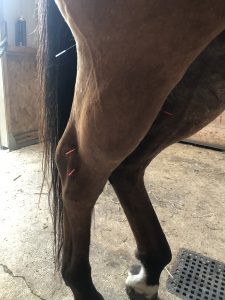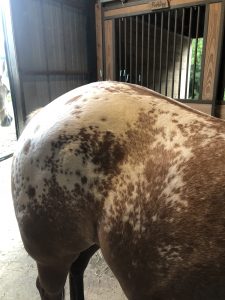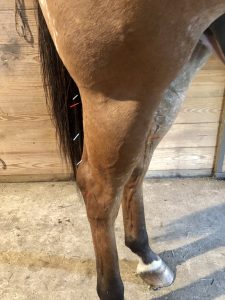Abstract:
A 12-year-old Appaloosa gelding presented with a history of hock osteoarthritis and an acute hind limb lameness. Fifteen-minute dry acupuncture sessions were performed over the course of two weeks. The results of these treatments included improved mobility and enhanced pain control.
History and Presentation:
Cool is a 12-year-old Appaloosa gelding with a history of mild hock osteoarthritis diagnosed by his regular veterinarian. He was treated with Adequan last fall but is not receiving any medications currently. Cool is dewormed routinely and receives vaccinations annually. He is pastured with three other horses and has easy access to the barn for shelter. The terrain of the pasture is grass and sand, and his owner will occasionally give the horses access to new areas of pasture by opening up the dividing gates. Cool is used for 4-H gymkhana. His owner reports that Cool has recently been “off” on his right hind limb. He is thought to have injured the limb while being turned out on a new pasture. He is scheduled to be shown in a horse show in early September, so his owner is hoping that the acupuncture sessions will help him become more sound.
Physical Examination and Clinical Assessment:
Cool was bright, alert, and responsive on initial presentation. Vital parameters were within normal limits. Body condition score was 6/9. His hind limb gait was stiff, and he had a grade 2-3/5 right hind limb lameness using the lameness scale guidelines provided by the American Association of Equine Practitioners (AAEP). Palpation of both hocks revealed joint thickening, effusion, and decreased range of motion. Mild swelling and heat of right stifle was also noted on palpation. Cool displayed discomfort on hind limb flexion bilaterally—more severe discomfort noted on flexion of the right hind limb. Myofascial examination revealed sensitive, taut muscle bands within the triceps brachii and supraspinatus muscles bilaterally. Cool also had taut muscle bands within his latissimus dorsi and his epaxial muscles bilaterally.
Problem List:
• Grade 2-3/5 right hind limb lameness
• Bilateral hock joint thickening
• Decreased hock range of motion
• Swelling and heat of right stifle
• Triceps brachii and supraspinatus trigger points
• Taut muscle bands within latissimus dorsi and epaxial muscles
Differential Diagnosis:
Right hind limb lameness
Vascular: Laminitis, thrombus, vasculitis, vascular hamartoma, ischemia
Infectious: Septic arthritis, hoof abscess, cellulitis, myelitis, Lyme disease, Equine Protozoal Myeloencephalitis
Neoplastic: Osteosarcoma, chondrosarcoma, fibrosarcoma, lymphoma, lymphosarcoma, nerve sheath tumor
Degenerative: Degenerative joint disease, intervertebral disc disease
Iatrogenic/Intoxication: Farrier-induced lameness, poor pasture conditions
Congenital: Osteochondritis dissecans
Autoimmune: Immune-mediated polyarthritis, equine fibromyalgia syndrome
Traumatic: Fracture, soft-tissue injury, bursitis, neuritis
Endocrine/Metabolic: Hyperadrenocorticism, equine metabolic syndrome
Myofascia: Soft-tissue injury, myofascial restriction
Bilateral hock thickening and effusion
Vascular: Vasculitis, edema, thrombus
Infectious: Septic arthritis, cellulitis, tenosynovitis
Neoplastic: Osteosarcoma, chondrosarcoma, osteochondroma
Degenerative: Degenerative joint disease
Iatrogenic/Intoxication: Farrier-induced lameness, joint-injection complications, poor pasture conditions
Congenital: Osteochondritis dissecans
Autoimmune: Immune-mediated polyarthritis
Traumatic: Fracture, soft-tissue injury, bursitis
Endocrine/Metabolic: Hyperadrenocorticism, equine metabolic syndrome
Myofascia: Myofascial inflammation
Definitive Diagnosis:
Hock osteoarthritis with secondary myofascial strain and an acute soft-tissue injury was determined to be Cool’s definitive diagnosis. Thinning of cartilage and formation of bony spurs around his hock joints caused inflammation, nerve impingement, and abnormal joint function. Additionally, Cool seemed to have further injured his arthritic joint and the surrounding soft tissue structures of his right hind limb. The soft tissue injury seemed to affect the musculature surrounding his stifle.
Medical Decision Making:
Cool’s acupuncture treatments were focused on providing generalized pain relief to address osteoarthritis in both hind limbs, relief of pain associated with his acute right hind limb soft-tissue injury, and reduction of trigger points in his shoulders and epaxial muscles caused by compensatory hind limb off-loading. During these treatments, central points, autonomic points, and peripheral points were utilized in order to obtain a more thorough pain-management protocol (GV 14, LI 16, SI 12, Bai Hui, GB 34, GB 39, ST 36, SP 6, KI 3, BL 18, BL 23, BL 25, BL 26, BL 27, BL 39, BL 40, BL 60, BL 62)




Medical Acupuncture and Related Techniques Used:
Treatment 1: Dry Needling
Needles Used: Seirin No. 1 (0.16) x 15mm, Seirin No. 3 (0.20) x 30mm
Points Treated: GV 14, LI 16 (bilaterally), SI 12 (bilaterally), GB 34, GB 39, Bai Hui, BL 40, BL 60, BL 62, KI 3, ST 36 (bilaterally), triceps trigger points (bilaterally)
Treatment 2: Dry Needling
Needles Used: Seirin No. 1 (0.16) x 15mm, Seirin No. 3 (0.20) x 30mm
Points Treated: GV 14, LI 16 (bilaterally), SI 12 (bilaterally), GB 34, GB 39, Bai Hui, BL 18 (bilaterally), BL 23 (bilaterally), BL 26 (bilaterally), BL 40, BL 60, BL 62, ST 36 (bilaterally), triceps and supraspinatus trigger points (bilaterally)
Treatment 3: Dry Needling
Needles Used: Seirin No. 1 (0.16) x 15mm, Seirin No. 3 (0.20) x 30mm
Points Treated: GV 14, LI 16 (bilaterally), SI 12 (bilaterally), GB 34, GB 39, Bai Hui, BL 25 (bilaterally), BL 26 (bilaterally), BL 27 (bilaterally), BL 40, BL 62, SP 6, ST 36 (bilaterally), triceps and supraspinatus trigger points (bilaterally)
Outcome:
Cool handled his initial treatment well and relaxed significantly soon after placement of GV 14 and Bai Hui. He was sensitive on placement of some hind limb points during his first treatment, but got better for their placement during subsequent treatments. Following treatments, there was noticeable improvement in his right hind limb lameness, and his right hind limb gait appeared less stiff. He was much more relaxed during gait assessment after his treatment sessions and was therefore walking at a slower pace. Although his owner noticed significant improvement after our treatment sessions and a few days of rest, she opted to keep him home from the horse show the following weekend so he could rest up for a bigger show he was scheduled to perform in later in the month.
Discussion:
As a newly graduated veterinarian it has been a very exciting time of new experiences and continued learning. I am excited to be able to offer veterinary acupuncture as an adjunct to traditional pain control methods. It was encouraging to see Cool improve after three acupuncture sessions. I feel that acupuncture was able to address multiple problem areas that were affecting Cool, including muscle soreness, nerve impingement, and joint pain. In the future I would like to be able to offer my equine patients electroacupuncture and laser as additions to my multi-modal treatment approach.
References:
Dunkel, B., Pfau, T., Fiske-Jackson, A., Veres-Nyeki, K. O., Fairhurst, H., Jackson, K., … Bolt, D. M. (2017). A pilot study of the effects of acupuncture treatment on objective and subjective gait parameters in horses. Veterinary Anaesthesia and Analgesia, 44(1), 154–162. doi: 10.1111/vaa.12373
Mariani, L. P., Sampaio, F., Silveira, A. B., Bastos, L. F., Weber, S. H., & Michelotto, P. V. (2019). Pressuring of Acupoints as a Complement to the Diagnosis of Stifle Diseases in Horses. Journal of Acupuncture and Meridian Studies, 12(5), 151–159. doi: 10.1016/j.jams.2019.06.001